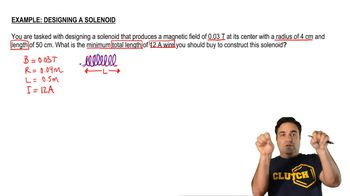The two tightly wound solenoids below both have length 40 cm and current 5 A in the directions shown. The left solenoid has radius 20 cm and 50 m of total wire. The right solenoid has radius 0.5 m and 314 m of total wire. The thinner solenoid is placed entirely inside the wider one so their central axes perfectly overlap. Assume wires don't touch. What is the magnitude and direction of the magnetic field that is produced by a combination of the two solenoids at their central axis?
(Note:your worksheet may have a typo and say "0.5 cm"for the right solenoid's radius; it should be 0.5 m.)






